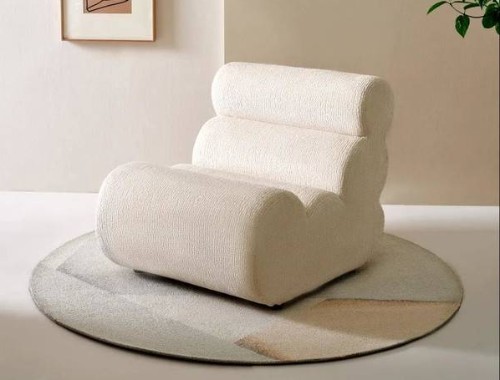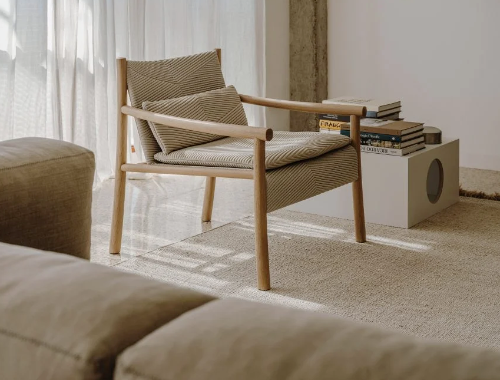West Michigan furniture companies to debut reshaped workspaces at NeoCon show in Chicago
This week, West Michigan’s office furniture industry heads to Chicago’s Merchandise Mart for NeoCon, a collective unveiling of the latest products. These new desks, chairs, tables and sofas are also a reflection of how we are working, learning and healing
This week, West Michigan’s office furniture industry heads to Chicago’s Merchandise Mart for NeoCon, a collective unveiling of the latest products. These new desks, chairs, tables and sofas are also a reflection of how we are working, learning and healing differently than even a decade ago.
We are more mobile, casual and flexible about where we work.

Steelcase employees have a meeting in one of their new media:scape products last week in the company showroom. Steelcase will be showing the latest in media:scape this week at NeoCon.
Since nobody wants to feel like they are always working, the institutional look of the office, school and hospital is giving way to furnishings with a more residential feel, evoking the comfort of a stylish living room or trendy coffee shop.
Private workspaces — from the coveted corner office to the lowly cubicle — are disappearing to make room for employees to work in collaboration, a growing strategy by companies to quickly respond to an ever-changing global marketplace.
Classrooms are segueing from a static environment focusing eyes on the sage at the podium to mobile desks that make it easier for students to interact as they are coached by their teachers.
Hospital rooms are being designed not just to set patients at ease but invite family members to remain by their side, and free up nurses for more clinical duties.
It’s a new eco-system, said Chuck Saylor, who has watched the evolution from the airtight buildings erected post-World Ward II when the nation craved security, secrecy and hierarchy to today’s demand for sustainability, collaboration and accessibility.
“We are deconstructing the office environment as we speak,” said Saylor, founder and CEO of the Spring Lake-based IzzyPlus. “You don’t want to be in the middle of deconstruction and not be innovative.”
Those innovative designs reflect extensive research into the ways technology is changing how we live and work.
Casual environment
When a Steelcase researcher followed 15 people home, she discovered they weren’t working in their home offices but on the family room couch or at the kitchen table where they could connect with their family.
“Wireless technology has allowed people to integrate their life and work in ways they haven’t been able to,” said Tom Di Lillo, director of marketing communications for Grand Rapids-based Steelcase’s Coalesse brand.
To meet that need for a casual workspace, Coalesse is introducing Millbrae, lounge seating and occasional tables for lobby, lounge and residential settings, inspired by the mid-century designs of the Metro Furniture brand.
Zeeland-based Herman Miller also is reaching back into its archives to relaunch iconic designs from the 1959 Eames Aluminum Group and an updated version of the Eames lounge with new option for finishes.

Haworth Inc. marketing manager Lydia Knowles, left, and field sales representatives Bill and Richelle Black sit in models of the Holland company's Very seating system chairs last week during a break from a training session.
“It’s back to being furniture again,” said Rob Kirkbride, who writes about the industry for the trade publication The Monday Morning Quarterback. “Which is pretty nice, from a design standpoint, because it allows designers to create beautiful things instead of giant stuff that just holds my computer.”
Now that people can take their technology anywhere, they want choices and flexibility where they work.
Companies are creating furniture that offers the ambience of a Starbucks cafe, a living room or even a patio to make the office a place where employees want to work.
While Starbucks might be credited for creating a hip alternative to the work or home office, the cafe has its drawbacks. The tables are too small. There aren’t the high-tech tools from white boards to monitors to share ideas. Then, there are confidentiality issues. You never know if the competition is drinking a latte at the next table, said Chris Congdon, part of Steelcase’s public relations team.
Workplace collaboration has grown to occupy 80 percent of a typical worker’s day, up from 20 percent group work time a decade ago, according to Steelcase research.
To make room for these new collaborative spaces, companies are shrinking or eliminating offices and cubicles. The 8-by-8 foot cubicle has been trimmed back to an average 6-by-6. As cubicle space shrinks, the walls are coming down.
Private space is no longer an indicator that you have made it in a company. Herman Miller’s vice presidents share a bank of desks — though, on a recent visit, they all sat empty.
“Now, I think mobility is more a status symbol,” Congdon said.
More employees are carrying their workstations in a backpack.

Herman Miller director of workplace solutions Lori Gee settles into a Canvas Office Landscape benching station at the Design Yard facility in Holland.
Furniture giants Steelcase, Herman Miller and Haworth are offering versions of “benching,” a long table where workers are side-by-side and across from each other as if sitting down to a meal.
Although benching is common in most European offices, it is being offered in the North American market as an option for workers who need temporary work space where they can plug in or for a highly collaborative team.
“Organizations have to be nimble because the pace of business is changing so much,” said Ryan Anderson, Steelcase’s manager of integrated technologies. “That revelation is what leads people to us. The space needs to reflect what they are doing.”
Even for those who still work at the same desk, they are being encouraged to move. More companies are ordering barstool-type chairs or seating and desks that can easily raise from sitting to standing level.
“We are seeing more standing working stations,” said Tom DeBoer, Haworth’s product manager for seating. “The human body wasn’t designed to sit all day.”
Education, health care
Office furniture companies are taking these furniture solutions into the education and health care markets.
Movement and interaction are increasing a focus of learning environments for K-12 and beyond.
Nearly one-third of Steelcase’s media:scape units, which combine technology in a gathering space — are purchased by universities or colleges. UCLA swapped some of its stacks of books in its libraries for Steelcase’s canopy media:scape to provide a space where students can interact with technology.

The Layla conference table by IzzyPlus
Project Nemo is a concept piece IzzyPlus is developing for the higher ed market. It features a bar-height table so students can gather on foot or chair.
Project Nemo is designed to promote connection or spontaneous collaboration or a place to study in solitude.
In health care, the hospital room looks more like a hotel room with chairs and sofas that quickly transform into beds so family members can be with patients through the night.
“They really want the family to stay because they help take care of the patient,” said Jan Carlson, vice president of marketing and product development for Steelcase’s Nurture line.
Herman Miller Healthcare’s Compass products offer a modular system from heated treatment chairs to overbed lights that be reconfigured around new technology.
“The only thing constant in health care is change,” said Joel Vanwyk, director of the company’s Healthcare Product Management.
While there are trends of mobility, flexibility and residential design, furniture companies are staking out different paths, said Kirkbride, who will be covering his 12th NeoCon this week.
“Herman Miller is focused on the classics and mixing it back into the office, which is becoming residential,” Kirkbride said. “Steelcase this year is concentrating on the link between technology and work (while) Haworth is offering universal systems of products that fit everything together from a private office to benching.”
-

Quanyou teamed up with the fashion brand ANNAKIKI to launch a new joint product!
-

Outer, an outdoor furniture brand founded by Chinese, enters the Australian market
-

National Bureau of Statistics: The retail sales of furniture in the first three quarters reached 120.5 billion, an increase of 20.7%
-

Enveloping lounge chairs and lightweight office chairs from Arper feature

 沪公网安备31010402003309号
沪公网安备31010402003309号



